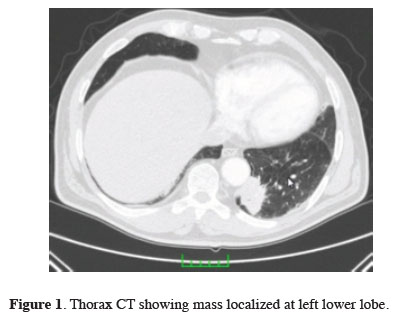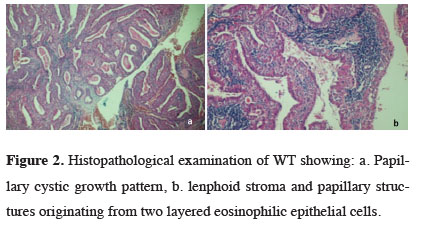2Department of Pathology, Kırıkkale University Faculty of Medicine, Kırıkkale, Turkey DOI : 10.26663/cts.2018.0004
Summary
Warthin's tumor (WT) is a salivary gland neoplasm, which is also called as papillary cyst adenoma lymphomatosis. Herein, we present an uncommon coexistence of WT in an 80-year-old patient with PET/CT positive cervical lymph nodes, during the diagnostic workup of a pulmonary mass lesion. Histopathologic diagnosis of the lymph node was reported as Warthin tumor and transthoracic biopsy of the mass as non-small cell lung carcinoma. We want to emphasize that it would be essential to identify patients with WT as an association with lung cancer was suggested in the recent literature.Introduction
Warthin's tumor (WT) is the second most common salivary gland neoplasm after pleomorphic adenomas [1]. It constitutes about 6-10% of all salivary gland tumors. 8% of WT is at extraparotid localization, periparotid and upper cervical lymph nodes that are known to be the regions where it is most commonly detected [2].Patients with lung cancer have been incidentally found to have WT and were misdiagnosed as metastatic disease based on radiologic imaging alone [3]. Here we present an 80-year-old man where PET/CT demonstrated positive cervical lymph nodes for a preliminary diagnosis of a lung tumor. The histopathologic examination of the excised lymph node is reported as a WT.
Case Presentation
An 80-year-old man presented with complaints of cough and shortness of breath started one month previously. He also defined pain at right leg, lumbar region and iliac bone. He had 40 packets/year of smoking history. The physical examination revealed enlarged lymph nodes in the right submandibular and right cervical region on palpation. Routine biochemistry and hemogram results were in normal ranges except, erythrocyte sedimentation rate 65 mm/h and CRP 10 mg/L. The FEV1 was 0.7 L and FVC was 1 L.Thorax computerized tomography (CT) showed a 44.5x36.6 mm mass lesion with spicular margins in the posterobasal segment of the left lower lobe close to thoracic aorta at 9th thoracic vertebra level (Figure 1). PET/CT examination demonstrated pathologic 18F- FDG uptake in the defined lesion and bilateral cervical, left hilar and mediastinal lymph nodes. Pathologic uptake was also reported at right iliac bone totally and sacroiliac joint showing sclerotic and lytic changes.
 Click Here to Zoom |
Figure 1: Thorax CT showing mass localized at left lower lobe. |
An excisional biopsy of palpable right upper cervical lymph node was performed for tissue diagnosis. Histopathological examination of the lymph node revealed a different tumor growth from lung carcinoma, which contained double row epithelial papillae structures and cystic areas, and central germinal marked lymphoid tissue under the oncocytic epithelium and the pathologic findings were compatible with the WT (Figure 2).
 Click Here to Zoom |
Figure 2: Histopathological examination of WT showing: a. Papillary cystic growth pattern, b. lenphoid stroma and papillary structures originating from two layered eosinophilic epithelial cells. |
The patient underwent a transthoracic percutaneous fine needle aspiration biopsy for the left lung mass after a nondiagnostic fiberoptic bronchoscopy, which was reported as non-small cell lung carcinoma (NSCLC) resembling a poorly differentiated adenocarcinoma. Considering PET/CT examination data and comorbidities, histopathologic confirmation of mediastinal lymph nodes were not performed. He was deemed inoperable and directed to the department of medical oncology. The patient died approximately 4 months later after a cerebrovascular accident.
Discussion
Warthin tumor is frequently originated from parotid gland and constitutes 5-10% of benign parotid neoplasms [4]. Oral cavity (palate and lips) and larynx localization have been reported. It is also noted that it may be bilateral in 3-10% of the cases and it may be in multiple localizations in 12% [5]. Histologically it contains a stroma consisting of dense, lymphoid tissue that fills between two-layered long columnar and oncocytic epithelial cells forming papillary structures. Cystic structures are present in the stroma [6]. WT can be seen at any age, with a peak incidence at 6th and 7th decades. In males like in this case, it is seen 10 times more frequently than females. However, in recent years, the rate of incidence in females has increased which is associated with the increase in the number of women who are smokers [7]. Although it has been a century since its definition, the etiopathogenesis of the tumor is still unknown. It is believed that genetic and/or environmental factors, nutritional and metabolic deficiencies, chronic infections play a role in the development of WT by these inclusions [8].The majority of WTs are localized in the parotid gland and in 4-10% of patients, they are multicentric and/or bilateral. It grows very slow and it is painless. The current size doubles approximately in 20 years [9]. Pain and fast growth is very rare and suggests a malign transformation, which was reported as 0.06-3% [10]. 8% of WT is at extraparotid localization, periparotid and upper cervical lymph nodes that are known to be the regions where it is most commonly detected [2]. Rapid growth and/or painful lesions especially in the extraparotid localization, creates serious diagnostic difficulties like in this case.
Routine MR imaging protocol at diagnosis is often insufficient [9]. 18F- FDG PET-CT should be used to show the high glucose metabolism in WT [11]. WTs with serious FED involvement is reported as 6-24% [5]. In this case the SUV max value of lung mass was 10.2, mediastinal lymph nodes were between 3.2 to 4.4 and cervical lymph nodes was between 8.5 to 14, where the later was the value of the excised one (WT). Although this SUV max value was considered to be high for a metastatic lymph node, it is compatible with the serious FED involvement of WT as reported in the literature.
Smoking is accepted as the primary etiologic factor and frequently reported in the literature similar to our patient, who was a heavy smoker. Kotwall et al reported that WT is seen eight times more in smokers compared with non-smokers [12]. As smokers have an increased risk for lung cancer, it is not surprising that those with WT are also have a risk of lung cancer.
In the English literature WT and lung cancer coexistence is very rarely reported. Dua et al [13] reported a case with bilateral synchronous and multifocal WT mimicking metastasis from lung cancer, Arora et al [14] reported 3 cases, and Thomas et al [15] reported 2 cases. Although there has been no proven association, a retrospective study by White et al [3] reported that, among 144 patients with WT, 24 (19%) had a concomitant lung cancer, the most common being NSCLC. They suggested that given the association between WT and lung cancer, earlier recognition of these benign lesions might potentially facilitate earlier diagnosis of lung malignancies [3].
As a conclusion, Warthin's tumors that are found at an extraparotid localization might cause a diagnostic dilemma, when they show intense FGD uptake. An appropriate tissue diagnosis should be performed for the misinterpretation of a metastatic disease. Foremost, it would be essential to identify patients with WT, as an association with lung cancer was suggested.
Declaration of conflicting interests
The authors declared no conflicts of interest with respect to the authorship and/or publication of this article.
Funding
The authors received no financial support.
Reference
1) Naujoks C, Sproll C, Singh DD, Heikaus S, Depprich R, Kübler NR et al. Bilateral multifocal Warthin's tumors in upper neck lymph nodes.report of a case and brief review of the literature. Head Face Med 2012; 3: 8-11.
2) Rodriguez Bigas MA, Sako K, Razack MS, Castillo NB. Extraparotid Warthin's tumor: an unexpected finding in three female patients. N Y State J Med 1990; 90: 465-6.
3) White CK, Williams KA, Rodriguez-Figueora J, Langer CJ. Warthin's tumours and their relationship to lung cancer. Cancer Invest 2015; 33: 1-5.
4) Chapnik JS. The controversy of Warthin tumor. Laryngoscope 1983; 93: 695-716.
5) Batsakis JG. Carcinoma ex papillary cystadenoma lymphomatosum malignant Warthin's tumor. Ann Otol Rhinol Laryngol 1987; 96: 234-5.
6) Teymoortash A, Krasnewicz Y, Werner JA. Clinical features of cystadenolymphoma (Warthin's tumor) of the parotid gland: retrospective comparative study of 96 cases. Oral Oncol 2006; 42: 569-73.
7) Orabona GA, Abbate V, Piombino P, Romano A, Schonauer F, Iaconetta G et al. Warthin's tumour: Aetiopathogenesis dilemma, ten years of our experience. J Craniomaxillofac Surg 2015; 43: 427-31.
8) Azzopardi JG, Hou LT. The genesis of adenolymphoma. J Pathol Bacteriol 1964; 88: 213e218.
9) Mistry SG, Gouldesbrough D, Bem C. Multifocal extraparotid Warthin's tumours mimicking metastatic squamous cell carcinoma of the upper neck. J Laryngol Otol 2015; 129, 513-6.
10) Hwang JY, Kim SW, Yang SC, Kim CD. Extraparotid Warthin tumor in upper cervical lymph node accompanied by primary cervical tuberculosis. Otolaryngol Head Neck Surg 2011; 144: 646-7.
11) Metser U, Miller E, Lerman H, Even-Sapir E. Benign nonphysiologic lesions with increased 18F- FDG involvement on PET/CT: characterization and incidence. AJR Am J Roentgenol 2007; 189: 1203-10.
12) Kotwall CA. Smoking as an etiologic factor in the development of Warthin's tumour of the parotid gland. Am J Surg 1992; 164: 646-7.
13) Dua SG, Purandare NC, Shah S, Rangarajan V. Bilateral synchronous and multifocal Warthis tumor mimicking metastasis from lung cancer: A rare cause of false positive flourodeoxy glucose positron emission tomograpy/computed tomography. Indian J Nucl Med 2012; 27: 139-40.






